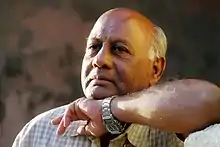Shrikant Shah | |
|---|---|
 Shah at Ahmedabad on 8 July 2006 | |
| Born | 29 December 1936 Bantva, Junagadh district, Gujarat |
| Died | 22 January 2020 (aged 83) Ahmedabad |
| Pen name | Niranjan Sarkar |
| Occupation | Professor, poet, novelist, short story writer, playwright |
| Language | Gujarati |
| Nationality | Indian |
| Education | Master of Arts |
| Alma mater | Bahauddin College, Junagadh |
| Period | Modern Gujarati literature |
| Notable works | Asti (1966) |
| Spouse |
Ruta Shah (m. 1963) |
Shrikant Vallabhdas Shah (29 December 1936 – 22 January 2020) was a Gujarati poet, novelist, short story writer and playwright from Gujarat, India, mainly known for his experimental novel Asti (1966).
Biography
He was born on 29 December 1936 in Bantva, a town in Junagadh district of Gujarat, to Vallabhdas and Vasantbahen. He completed schooling in his village Bantva. He completed Bachelor of Arts in 1959 and Master of Arts in 1961 from Bahauddin College, Junagadh with Psychology Subject.[1]
He started his career as lecturer at H. K. Arts College, Ahmedabad in 1962-63. Thereafter, he served as an employment officer at Jamnagar, a manager of Jansatta daily at Rajkot and general manager of Jansatta at Ahmedabad. He retired as lecturer from Vivekanand College, Ahmedabad.[1]
He married Ruta Shah on 9 November 1963, and they had a daughter and a son. He resided in Ahmedabad.[2]
He died on 22 January 2020.[3]
Work
He started writing under pseudonym Niranjan Sarkar.
In 1962, he published his first collection of poems Ek and wrote his existentialist novel Asti which was published in 1966, followed by mystery novel Trijo Manas. Tirad ane Bija Natako, Negative, Canvas Par Na Chahera, ...Ane Hu and Aekant Number 80 are his plays. In 2003, his poetry collection Ek Manasnu Nagar was published with the preface written by Gujarati author Niranjan Bhagat. Some of his books are awarded by Gujarati Sahitya Parishad and Gujarat Sahitya Akademi.[1]
Asti is his experimental novel which is considered as his attempt of modern novel.[4] The novel does not have any plot and is centred around an unnamed individual addressed as “Te” (lit. He) who passes through ugly experience of existence and desires death.[5]
References
- 1 2 3 Bhuptani, Maulik. "SHRIKANT SHAH, Gujarat Sahitya Academy, સર્જક અને સર્જન, શ્રીકાન્ત શાહ". Gujarat Sahitya Akademi. Retrieved 19 January 2017.
- ↑ Sharma, Radheshyam (2010). Saksharno Sakshatkar (Question-based Interviews with biographical literary sketches). Vol. 16. Ahmedabad: Rannade Prakashan. p. 362.
- ↑ Vora, Kamal; Mehta, Naushil; Doodhat, Kirit, eds. (October–December 2019). "Obituary". Etad. Mumbai: Kshitij Sanshodhan Prakashan Kendra. p. 76. ISSN 2350-0689.
- ↑ K. M. George (1992). Modern Indian Literature, an Anthology: Surveys and poems. New Delhi: Sahitya Akademi. pp. 141–. ISBN 978-81-7201-324-0. Retrieved 20 January 2017.
- ↑ P. K. Rajan (1989). The Growth of the Novel in India, 1950-1980. New Delhi: Abhinav Publications. p. 74. ISBN 978-81-7017-259-8. Retrieved 20 January 2017.
External links
- Shrikant Shah on GujLit
- Shrikant Shah in Gujarati Vishwakosh.